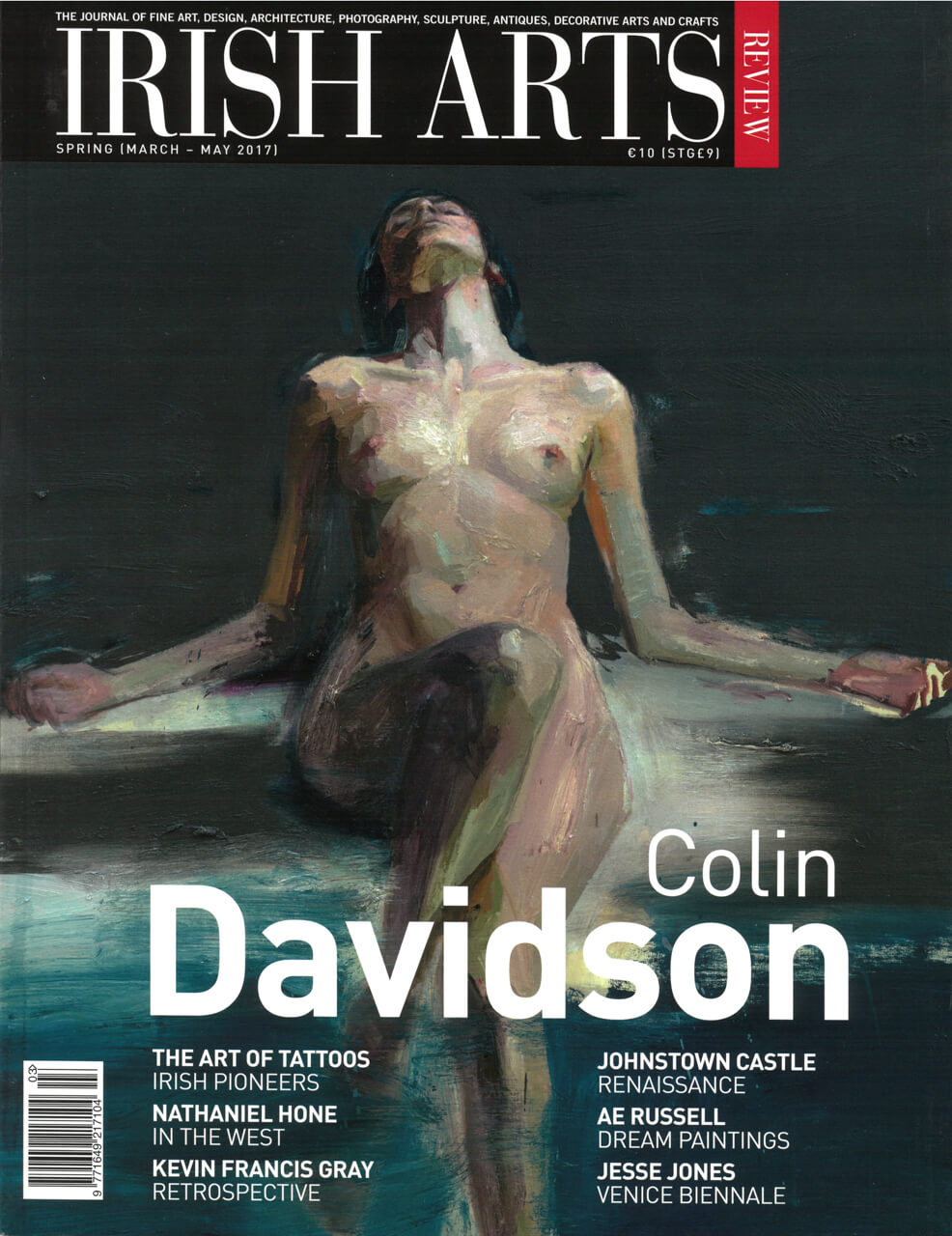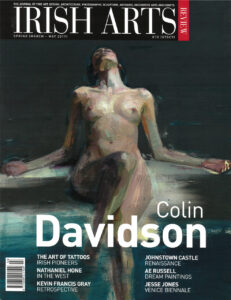

Peter Murray recalls the independent spirit Edith Blake, diarist and artist and one-time occupant of Myrtle Grove, Youghal, County Cork
Born in 1845 at Newtown Anner, near Clonmel, Edith Blake (née Osborne) is best known today as a botanical artist, but over the course of her long lifetime she was also an accomplished travel writer and diarist. The eldest daughter of Catherine Isabella Osborne and Ralph Bernal Osborne (1808-1882), Edith was born into a wealthy and colourful landowning family (Fig 2). The Osbornes owned estates in Tipperary and Waterford, including copper mines along the coast. Edith’s grandfather, Ralph Bernal was an outspoken member of Parliament, serving also as Secretary of the Admiralty. A Whig MP Ralph senior, inherited estates in Jamaica and built up a collection of glass, ceramics and miniatures, much of which now in the V&A.
Ralph junior, also an MP, married Catherine Osborne, adding his wife’s name to his own. The match was not a success: indeed the couple seem to have loathed one another. Bernal remained in London, while his wife stayed on at her home in Ireland, where she lived an independent life, raising their two daughters, Edith, born in 1845, and Grace, born three years later. Bernal had married for money, and resented that he was never given what he felt was his due. Edith disliked her philandering father, and revered her mother as a ‘suffering angel.’ When Edith was in her late teens, her mother wrote a novel called False Positions. Published anonymously, it was a thinly disguised attack on her husband.
A proficient artist, Catherine passed this talent on to her daughter, and during their time at Newtown Anner, the house became a haven for artists and friends. Even as a child, Edith’s paintings showed talent and skill. Aged twenty-six, in February 1872, accompanied by a clergyman, maid and a cousin, she embarked on a one-year tour of Europe. The diary she kept during this trip, noting details of architecture and local culture, was published in 1876 as Twelve Months in Southern Europe.
In spite of their differences, Catherine and Ralph were keen to arrange a suitable marriage for their daughter. However, Edith had ideas of her own and, aged twenty-eight, she eloped with Henry Arthur Blake (1840-1918), widower and County Inspector for the Irish Constabulary. In the ensuing row, Edith was disinherited and her name not mentioned again in the Osborne household.
In 1879, Edith published her second book, Realities of Freemasonry. Although defiant in the face of her parents’ wishes, she never renounced membership of a class she considered born to rule, and solidly supported her husband as he built up a career in that field. In 1876, Henry was appointed Resident Magistrate in Tuam and six years later was promoted to Special Resident Magistrate. With the Land Wars at their height, and Gladstone’s Coercion Act passed into law in 1881, Henry was in constant danger of assassination. Edith often travelled with her husband, armed with a cocked revolver, in case an attempt should be made on his life. However, she was not opposed to political reform. One of her close friends was Anna Parnell, sister of Charles Stewart Parnell. Anna had founded the Ladies’ Land League, a radical organisation that aided the main Land League by collecting information on estates in Ireland. Alarmed at the activities of the Ladies’ Land League, Charles Stewart Parnell brought about its dissolution, earning him the contempt of Edith.
In 1880, Catherine Osborne died at Newtown Anner. Ralph died two years later. Blake was given a knighthood but it was judged expedient that he leave Ireland. An attempt was made to have him appointed Governor of Queensland, but the hostility of the Irish in Australia made this impossible. Instead, in 1884, he was appointed Governor of the Bahamas. This was the first in a series of Colonial Office appointments that saw Henry and Edith stationed in the Bahamas (1884-1887), Newfoundland (1887-1888), Jamaica (1889-1897), Hong Kong (1897-1903) and Ceylon (1903-1917). As befitted the representatives of Empire, the Blakes lived in some style. At a fancy-dress party in the Bahamas, their children Olive, Maurice and Arthur, were painted by the artist Winslow Homer. When they moved on to Jamaica, both Henry and Edith were closely involved in organising the Jamaica Exhibition of 1891. Edith’s dress, embroidered with orchids on satin, was designed by Baroness Pauline Prochazka and made in the School of Art in Dublin.
Visitors to Jamaica included Lord Rosse, the Villiers-Stuarts, Eva FitzGerald, daughter of the 4th Duke of Leinster, the artist Emily Trant, of Dovea in Tipperary, and Lord Donoughmore, who was on his way back from Peru. Prince George of Wales, who was to officially open the exhibition, arrived at Port Royal with a fleet of warships, including the gunboat he commanded, HMS Thrush. However, Lord Rosse, sporting the Star of St Patrick and his Deputy Lieutenant’s ceremonial dress, was loudly cheered by the crowds lining the streets, who mistook him for the Prince. The Jamaica exhibition included a display of Edith’s collection of traditional implements and pottery, as well as Olive’s collection of moths and butterflies. Edith also exhibited a drawing of the landfall of Columbus, along with two painted screens.
During their travels, both Blakes contributed articles to journals and newspapers. To the magazine Nineteenth Century, Edith contributed articles on the Bahamas, Jamaica, the restoration of the Ming Dynasty, the position of women in China, Santa Sophia, the Sacred Bo Tree, and life and death in Ireland. The North American Review, Vol 167, 1898, contained an article by her on ‘The Maroons of Jamaica’, which addressed class distinction on the island. Her account of the 1891 exhibition was published in the Illustrated London News. While in Jamaica, the Blakes immersed themselves in efforts to improve the island’s economy through agriculture and tourism. Edith supported the construction of a marine laboratory and she and Henry were significant collectors of examples of Jamaica’s flora and fauna.
In addition to landscapes, Edith painted plants, fish, caterpillars, chrysalids and butterflies. One hundred and ninety-six watercolours by her, of moths and butterflies of Jamaica, are preserved in the Natural History Museum in London. The plants on which the butterflies and moths settle are depicted, as is the damage caused by their feeding, with larvae depicted in various stages. One of the finest of Edith’s lepidotera studies at Kew is Cocytius antaeus anteus Drury; giant sphinx moth. In the Blake family archive are also preserved diaries, letterbooks and paintings of Jamaican plants. Edith painted with succinct clarity and restraint, unlike the lush watercolours of Marianne North, the English botanical artist who also worked for a time in Jamaica. Edith corresponded with Daniel Morris at Kew, sending him consignments of seeds, including some from a white lotus she claimed was larger than Victoria Regia. In a letter to her sister Grace dated 17 April 1892, she wrote: ‘The flower is white about 9 or 10 inches in diameter. It looks to me nearly as large as the flower of the Victoria Regia but grows differently. It stands about a foot-and-a-half above the water on a long stalk, instead of lying on the water like the Victoria Regia'(Fig 3). Edith admired the flowers of Jamaica, in particular orchids, bignonia, gardenias, alamandas, poinsetta and hibiscus. Describing Jamaica as a ‘breathtaking emerald’ she described green ebony bushes in blossom, with ‘clusters of vivid topazes,’ in a letter to Grace, 1 May 1892. The efforts of European settlers in Jamaica to catalogue and classify the rich flora and fauna of the island was based as much on commercial aspirations as on scientific curiosity. The Blakes were part of a ‘fruit syndicate’, with Edith reporting in 1891 that their investment would yield a dividend of thirty per cent in that year. Coffee was a valuable crop as were bananas and cacao. Many botanic gardens were established, with those at Port Morant and Castleton attracting Edith’s attention. In 1892 she obtained two Homerus butterflies, at a cost of seven pounds, to send to England for the collection of Walter Rothschild. While on a cruise to the Turk Islands, in 1892, she sketched a ‘couple of the most brilliant fish, Captain Roome got from a fishing boat,’ [Edith to Grace, 11 June 1892]. Edith also painted screens, with one example, sent to the De La Poer family at Gurteen, decorated with large white flowers of Beaumontia Grandiflora in the centre, with mauve creepers on either side. Another screen, belonging to Henry, had white and chocolate ground orchids, Phagies Grandifolio. In 1894, Dr Ball organised an exhibition of Edith’s work at the Science and Art Museum in Dublin.
Edith Blake’s reputation rests mainly on the watercolours she did in Jamaica, but she also painted botanical studies in Hong Kong. Two species of oak, native to the New Territories, are named after the Blakes, as is the floral symbol of Hong Kong, the pink orchid tree Bauhinia Blakeana. Posted to Ceylon, Henry and Edith continued their work, founding an Agricultural Society along the lines of the successful organisation they had founded in Jamaica. In 1903, their daughter Olive married Jack Arbuthnot, an officer in the Scots Guards, who had served as ADC to Henry Blake in Hong Kong. Olive insisted that they honeymoon in a remote Buddhist monastery in Japan. A talented amateur painter and sculptor, Jack supplemented his income with journalism, and was the original ‘Beachcomber’ of the Daily Express. In 1914 he made a cross of broken glass from Ypres Cathedral. Two years later he made a series of sketches of Roger Casement, while the patriot was imprisoned, under his charge, in the Tower of London.
Following a long and successful career in the Colonial Service, in 1907 Henry Blake retired, aged sixty-seven years. He and Edith paid a final visit to Jamaica, before settling in Ireland, at Myrtle Grove in Youghal, a large Elizabethan house that they set about repairing and renovating. After his death in 1918, Edith remained in mourning for the rest of her life, rarely venturing outside the walls of Myrtle Grove. Through the services of a medium, a Miss Barlow, she attempted to make contact with Henry in the hereafter. Edith died at Myrtle Grove on 18 April 1926. On her death, on the recommendation of Lord Rothschild and Dr Charles Gahan, Olive presented the collection to the British Museum. It is now in the Natural History Museum in London. The youngest of Olive’s six children, the artist Patricia Cockburn, mother of the writers Patrick, Alexander and Andrew Cockburn, continued living at Myrtle Grove. Born in 1914, Patricia was educated at home and, like her grandmother Edith, embarked on a life of travel and adventure. She travelled in Africa and Asia, often under the auspices of the Royal Geographical Society. In 1939 she married Claud Cockburn, diplomatic correspondent of the Daily Worker, and worked on The Week, a lively newsletter he published. Settling in Youghal in 1947, Patricia and Claud later moved to Ardmore, where Patricia augmented the sporadic family finances by making exquisite shell pictures (Fig 8), which were exhibited in Cork, London and New York. She died in 1989. Myrtle Grove is now owned by her cousin Shirley Murray and is lived in by Shirley’s daughter Iona.
Peter Murray is co-editor of Twentieth Century, Art and Architecture of Ireland Vol V (2014).



